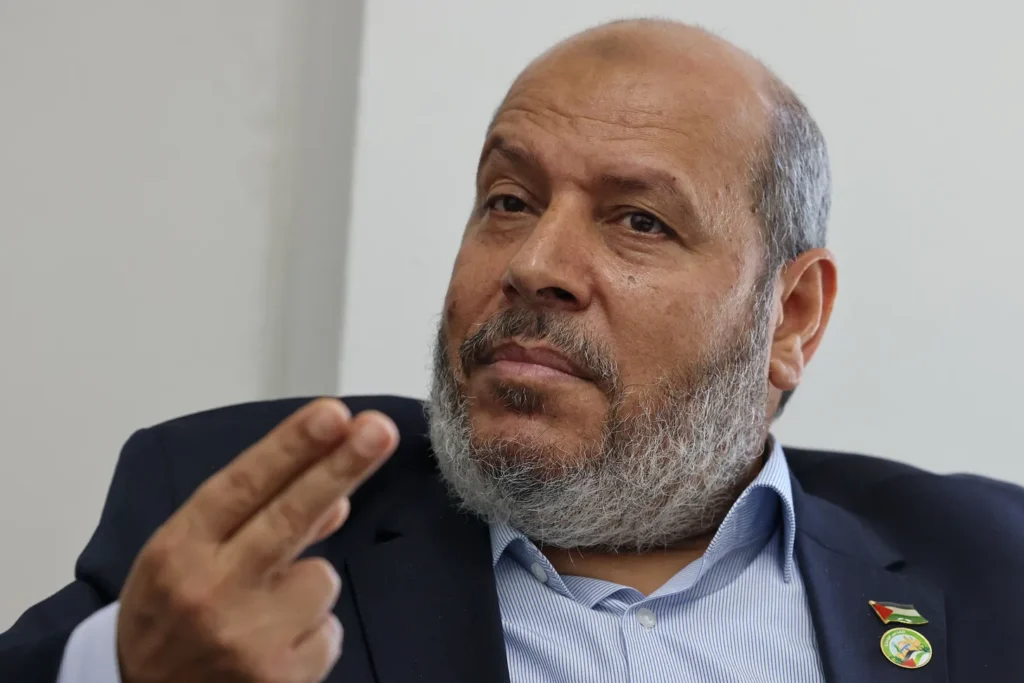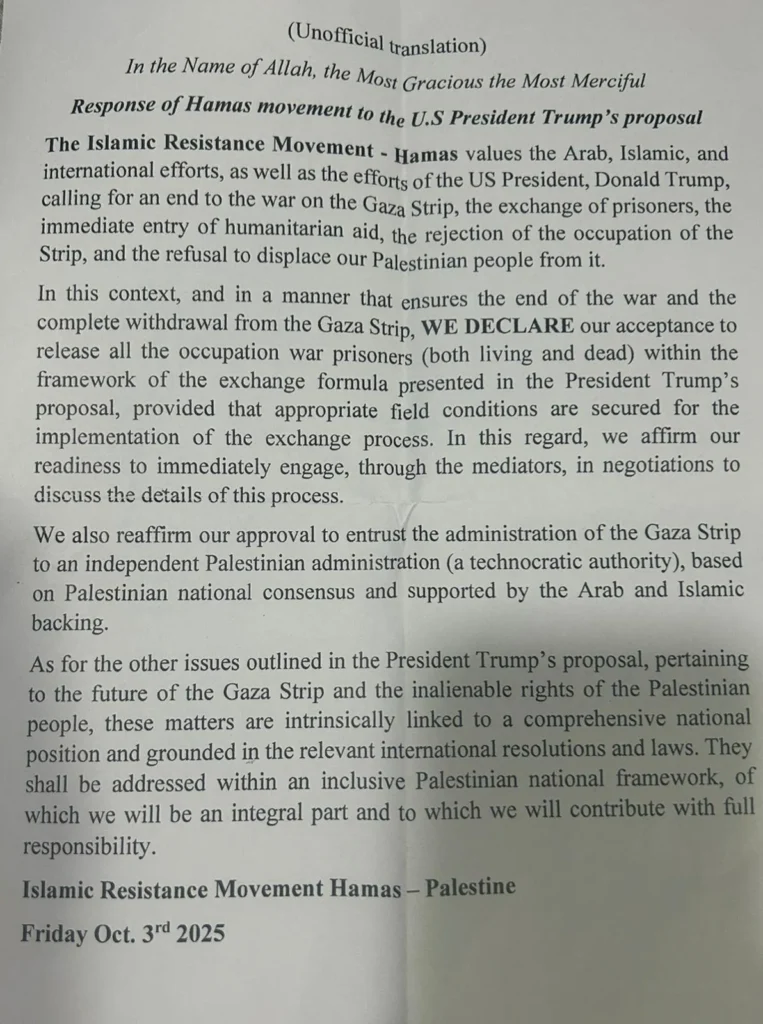Hamas’s Strategic Gamble
ANGLO AMERICA, 13 Oct 2025
Jeremy Scahill | Drop Site – TRANSCEND Media Service

Khalil al-Hayya, Hamas’s lead negotiator, survived an Israeli assassination attempt in Qatar on 9 Sep 2025.
Photo 2021 by EMMANUEL DUNAND/AFP via Getty Images.
While President Trump enthusiastically welcomed Hamas’s response to his Gaza plan, the White House and Israel deal in deception.
5 Oct 2025 – This week, as Palestinian negotiators led by Hamas gathered in Doha, Qatar, to craft their response to President Donald Trump’s 20-point plan for a Gaza ceasefire, they knew they were at a decisive crossroads. Trump had portrayed his plan, unveiled on Monday at the White House, as an ultimatum and both he and Prime Minister Benjamin Netanyahu said that if Hamas rejected the deal, then Israel would ratchet up its war of annihilation.
On the one hand, Trump’s proposal contained a series of terms for ending the war that align closely with a framework Hamas had agreed to just weeks earlier: an exchange of captives, a ceasefire, the resumption of deliveries of life essentials and humanitarian aid to Gaza, and the withdrawal of Israeli forces. While the terms laid out in Trump’s plan were vague, the basic structure to end the Gaza war was there.
On the other, the plan contained sweeping proposals that, if implemented, would have grave implications, not just for Gaza, but for the future of a unified Palestinian state. It included plans for the deployment of foreign troops and the establishment of an international board, headed by Trump and former British Prime Minister Tony Blair, to effectively dictate Gaza’s affairs. It also would leave open the likelihood of a long-term Israeli military presence inside Gaza and the total disarmament of Palestinians, erasing their right to resist Israeli occupation. Trump’s overarching message was that Palestinians must surrender their fight for liberation and submit to subjugation.
There was broad consensus among a wide range of Palestinian factions and parties that Hamas and Palestinian Islamic Jihad had the authority to negotiate an end to the active war in Gaza, according to several sources who participated in the discussions. There was also agreement that Hamas alone did not have a mandate to negotiate terms that would impact what the negotiators called issues related to the Palestinian homeland.
“Regarding the resistance factions, our jurisdiction is concerning matters of prisoner exchanges in return for halting the aggression, withdrawal, the entry of aid, and stopping the policy of displacement against our people,” said Mohammed Al-Hindi, the chief political negotiator for Palestinian Islamic Jihad, in an interview with Drop Site. “As for the national issues, the resistance factions are not authorized to speak on them alone, as these concern all factions and forces of the Palestinian people everywhere.”
The challenge before the negotiators was how to craft a response to Trump that would assert the Palestinian right to self-determination while persuading the erratic U.S. president to force Israel to cease its genocidal war.
The dominant pattern in previous ceasefire talks had been that Hamas’s proposals to amend Israeli-U.S. terms sparked false allegations that Hamas had rejected a deal, paving the way for more genocidal attacks. The Palestinian negotiators knew that proposing amendments or giving the impression they were rejecting any of Trump’s terms risked a return to that familiar and murderous cycle. But this time, there was a new constellation of interests.
Threading the Needle
When Trump announced his plan on Monday, he hailed it as “potentially one of the great days ever in civilization,” and boasted that his proposal would bring “eternal peace in the Middle East.” He claimed, repeatedly, that virtually every Arab and Muslim nation had endorsed his plan. This was not technically true, as the drafts provided to those countries prior to the White House announcement were substantially edited by Israel before the public roll-out.
Yet officials from these Muslim nations—most notably those from regional ceasefire mediators Qatar and Egypt—spoke of this Trump-enabled deception in only the most diplomatic of terms, opting to play along with his mythology in an effort to secure a deal. They all praised Trump for his initiative and emphasized that he was the key player to achieving peace.
Since Trump’s election, Hamas officials have said the only chance of halting Israel’s genocide resides with Trump. In the immediate aftermath of the release of the 20-point plan, Palestinian leaders from across the political landscape publicly denounced it as a surrender order and an attempt to use diplomacy to crush Palestinian resistance after Israel’s two year military assault had failed to achieve that goal.
A senior Hamas official told Drop Site that the group’s leadership understood that “this proposal was not put forward to find an end to the war. It is either total surrender or continue the war. Take it or leave it.” They viewed it as “catastrophic in the short and long term, for the resistance and for the whole Palestinian cause.” But on a strategic level, Hamas officials and other Palestinian leaders knew that formally rejecting Trump’s offer would be disastrous. The public narrative would almost certainly portray Hamas as rejecting peace even after a broad coalition of Muslim and Arab countries had endorsed it.
Over the course of the week, Hamas’s negotiators circulated proposed language among Palestinian factions and delivered it to the commanders from the Qassam Brigades and Hamas’s political leadership inside Gaza, according to two sources involved with the process. They also held lengthy meetings with officials from Egypt, Qatar, and Turkey.
Privately, some of these officials confirmed they had expressed support for a different version than the one Trump made public on Monday—and told Hamas negotiators they were appealing to Trump to roll back or discard some of the Israeli amendments. Trump allowed Netanyahu and his top adviser Ron Dermer to make significant changes to the terms, in some cases removing or substantively altering items that Trump’s Arab and Muslim “partners” had understood would be in the plan. While mediators from those nations pressed Hamas to accept the deal and cautioned against proposing any amendments or rejecting any specific terms, sources within the Palestinian negotiating team told Drop Site that, in the end, the mediators told Hamas negotiators it was ultimately a Palestinian decision.
By the time Trump announced Friday that he was giving Hamas until 6 p.m. Sunday to deliver its response, the Palestinian negotiators had already finalized their answer. Soon after Trump posted his deadline, the text was in the hands of Qatari and Egyptian mediators who swiftly delivered it to the White House.
It was a strategic gamble; at its core, Hamas’s response was not an unequivocal acceptance of Trump’s demands, but the text was also void of any language that explicitly rejected any of his terms. It was aimed at threading a needle by crediting Trump, linking him more closely to a diplomatic alliance with Arab and other Muslim nations, and sending a message that Hamas was embracing the essence of Trump’s plan. But it also needed to preserve Palestinian rights and, most significantly, defer any answer on most of the terms laid out in the proposal. The key goal was to achieve an immediate Gaza ceasefire and to win Trump’s buy-in to restrain Netanyahu’s bloodlust and to start real negotiations.
Hamas officials knew that what Trump most wanted to hear was an unambiguous commitment to release all remaining Israeli captives and that Hamas would step down from power in Gaza. In principle, this was not difficult. Hamas had repeatedly offered to enter into an “all for all” deal throughout the genocide and to free all Israeli captives. It also repeatedly said it would relinquish governance of Gaza to an independent technocratic committee composed of Palestinians. Even though these overtures had been systematically rejected or ignored by the U.S. and Israel for months, Hamas negotiators leaned into the idea of centering them. The hope was that Trump would celebrate these commitments from Hamas as his personal victory and the product of his demands.
TO CONTINUE READING Go to Original – dropsitenews.com
_______________________________________
 Jeremy Scahill – Journalist at Drop Site News, co-founder of The Intercept, author of the books Blackwater and Dirty Wars. Reported from Iraq, Afghanistan, Somalia, Yemen, etc.
Jeremy Scahill – Journalist at Drop Site News, co-founder of The Intercept, author of the books Blackwater and Dirty Wars. Reported from Iraq, Afghanistan, Somalia, Yemen, etc.
Drop Site News Middle East Research Fellow Jawa Ahmad contributed to this report.
Tags: Gaza, Genocide, Hamas, IDF, Israel, Netanyahu, Palestine, Trump, USA
DISCLAIMER: The statements, views and opinions expressed in pieces republished here are solely those of the authors and do not necessarily represent those of TMS. In accordance with title 17 U.S.C. section 107, this material is distributed without profit to those who have expressed a prior interest in receiving the included information for research and educational purposes. TMS has no affiliation whatsoever with the originator of this article nor is TMS endorsed or sponsored by the originator. “GO TO ORIGINAL” links are provided as a convenience to our readers and allow for verification of authenticity. However, as originating pages are often updated by their originating host sites, the versions posted may not match the versions our readers view when clicking the “GO TO ORIGINAL” links. This site contains copyrighted material the use of which has not always been specifically authorized by the copyright owner. We are making such material available in our efforts to advance understanding of environmental, political, human rights, economic, democracy, scientific, and social justice issues, etc. We believe this constitutes a ‘fair use’ of any such copyrighted material as provided for in section 107 of the US Copyright Law. In accordance with Title 17 U.S.C. Section 107, the material on this site is distributed without profit to those who have expressed a prior interest in receiving the included information for research and educational purposes. For more information go to: http://www.law.cornell.edu/uscode/17/107.shtml. If you wish to use copyrighted material from this site for purposes of your own that go beyond ‘fair use’, you must obtain permission from the copyright owner.
Join the discussion!
We welcome debate and dissent, but personal — ad hominem — attacks (on authors, other users or any individual), abuse and defamatory language will not be tolerated. Nor will we tolerate attempts to deliberately disrupt discussions. We aim to maintain an inviting space to focus on intelligent interactions and debates.
